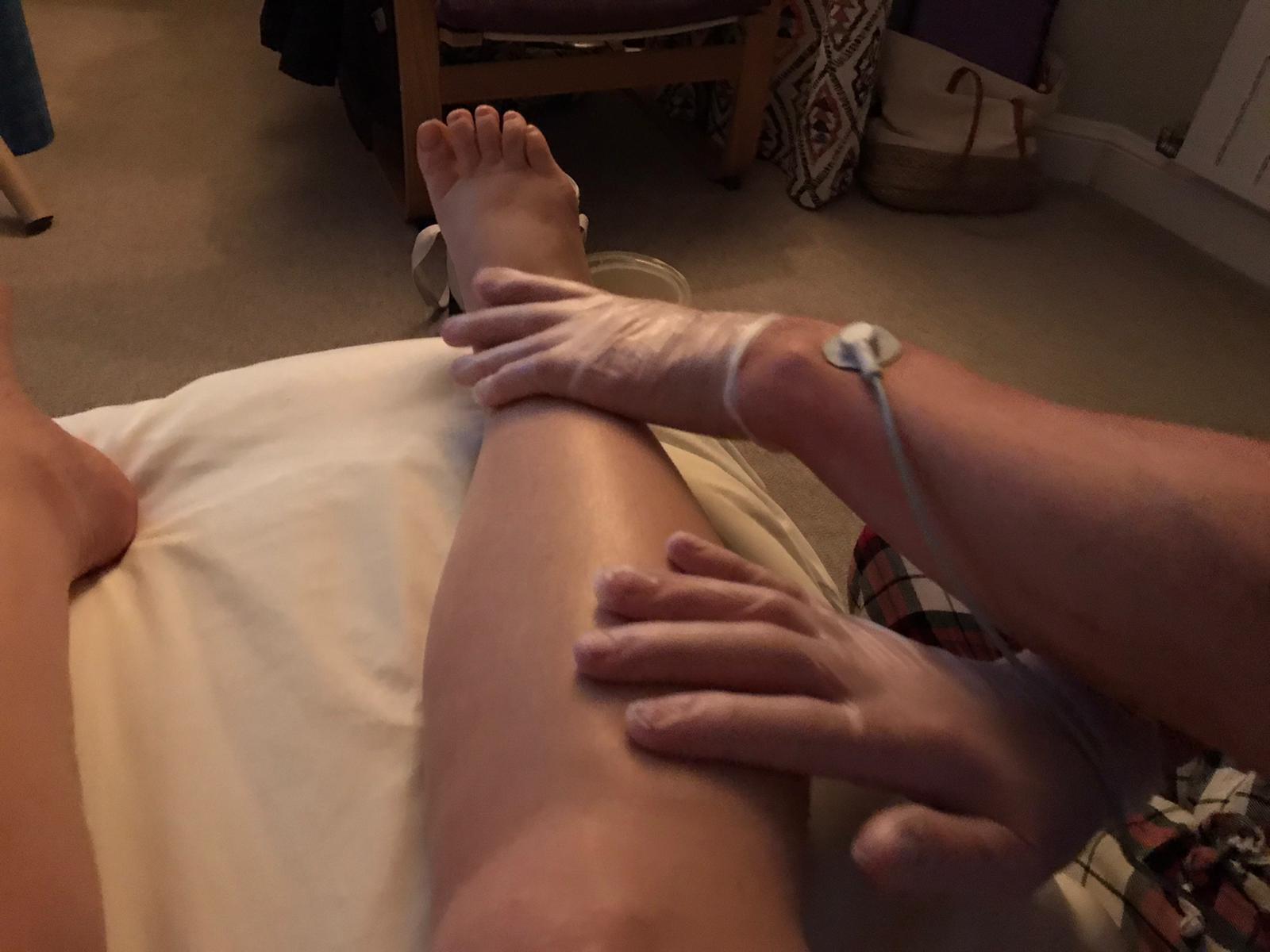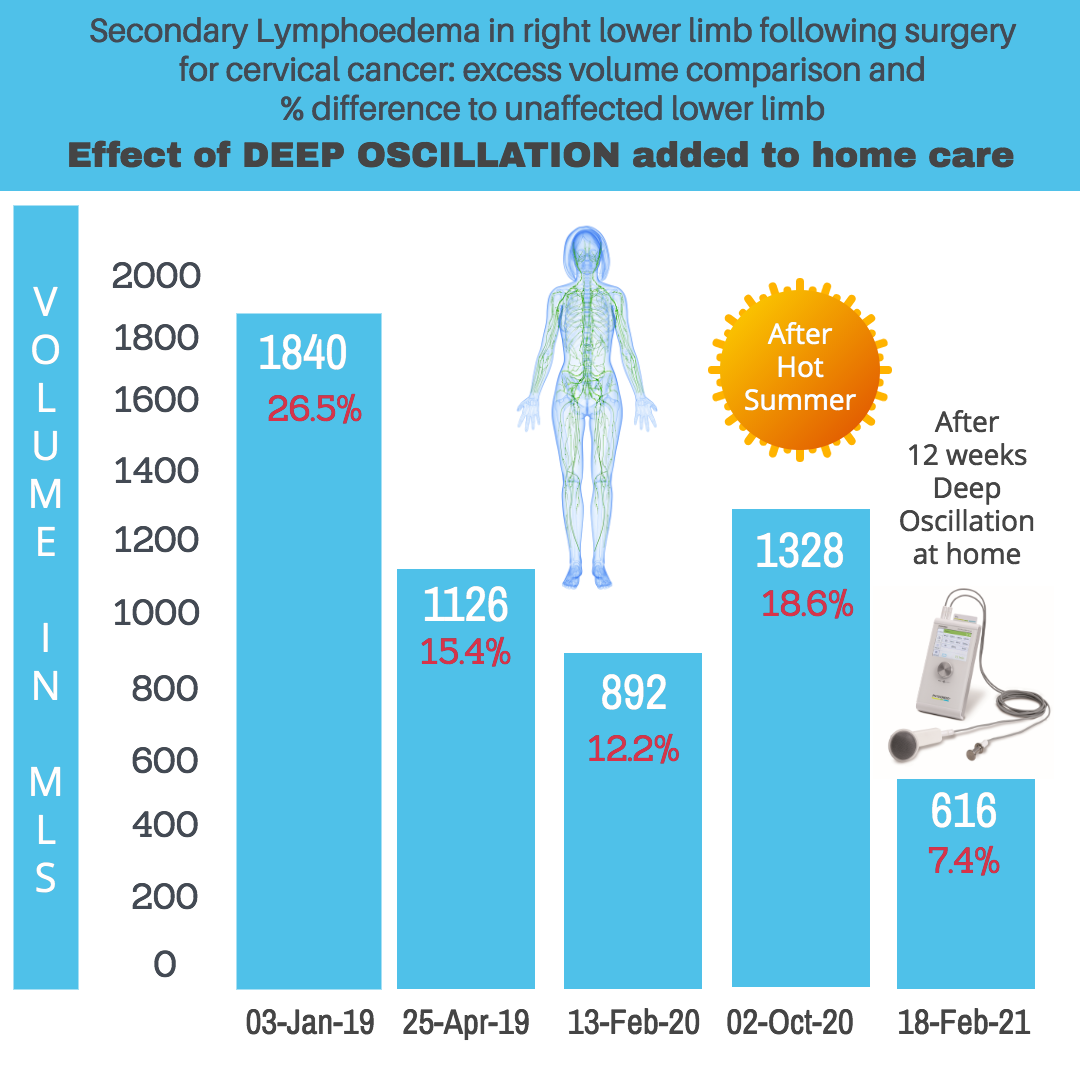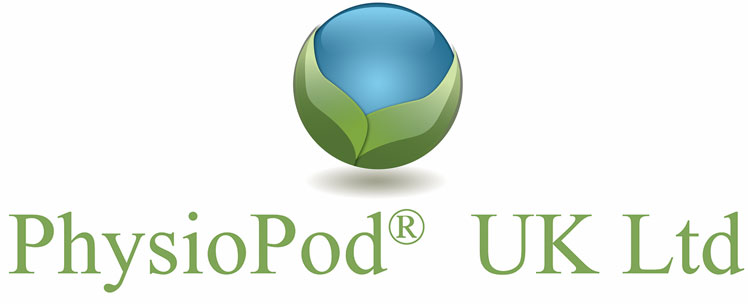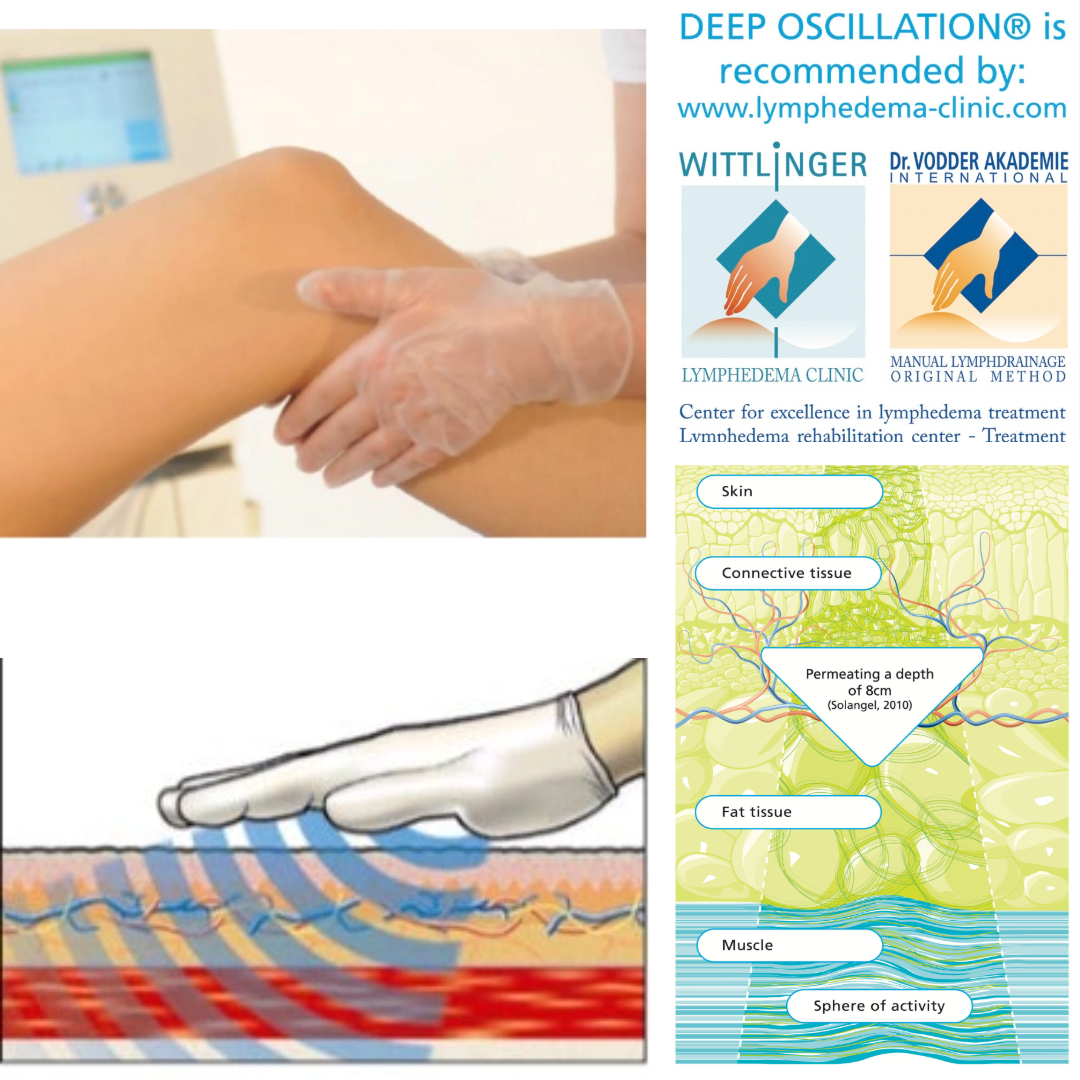Lower Limb Lymphoedema Standard Care & The Impact of Adding Deep Oscillation Therapy at Home
Mrs W purchased a Deep Oscillation Personal Basic for LLL treatment at home. Her husband applies deep oscillation to her lower limb daily via the gloved hands method on a preset Lymphoedema programme for 25 minutes and Mrs W self treats with applicators when she feels an additional treatment is required.
Background
Mrs W is a 57-year-old retired nurse and midwife who enjoys a full and active lifestyle. In 2013, aged 49, Mrs W was diagnosed with cervical cancer and underwent a radical hysterectomy, which also included the removal of several inguinal lymph nodes.
In the acute post-operative stage, Mrs W's right leg swelled, but she was advised that the swelling would reduce once normal activity resumed. Though the oedema did reduce, Mrs W noted that "it was always slightly larger than the other leg".
In 2018, after several visits to her GP, a referral was made to the local Lymphoedema Clinic where Mrs W was assessed, diagnosed and categorised with Stage 1, Lymphoedema of the right lower limb, with a recorded difference in lymph volume of 1840 mil, 26.5% larger than the unaffected limb.
"Lymphedema progresses through four stages. Stage 0 indicates a normal extremity clinically, but with abnormal lymph transport (i.e., illustrated by lymphoscintigraphy). Stage 1 is early oedema, which improves with limb elevation. Stage 2 represents pitting oedema that does not resolve with elevation. Stage 3 describes fibroadipose deposition and skin changes". (1)
.jpg)
A radical hysterectomy was performed removing several inguinal lymph nodes
Rebega et al 2020 (2) reported that "Lower Limb Lymphoedema represents one of the adverse reactions of multimodal treatment in gynaecological cancers which affects patient's quality of life. Lower Limb Lymphoedema occurrence is related with a number of risk factors, the most important being removed lymph nodes, obesity and radiotherapy" and with regard to the incidence of lower limb lymphoedema, Dessources et al 2020 (3) wrote "Lower extremity lymphedema is a chronic, often irreversible condition that affects many patients treated for gynecologic malignancies, with published rates as high as 70% in select populations"
Formulation of Lymphoedema Treatment Plan

A Decongestive Lymphatic Therapy (DLT) (4) plan was formulated to help control the symptoms and bring the Lymphoedema under control which included:
- Compression bandages, which complement exercise by moving fluid out of the affected limb and minimises further build-up
- Skin care advice – to keep the skin in good condition to reduce the chances of infection
- Exercises prescribed to use muscles in the affected limb to improve lymph drainage
- Measured for and prescribed a compression stocking - initially JOBST Opaque, CCL 1 progressing to JOBST Elvarex Custom Fit Class 18-21 mmhg
Manual Lymphatic Drainage (MLD) (an element of DLT) was not offered, instead instruction was provided on simple lymphatic drainage (SLD) to stimulate the flow of fluid in the lymphatic system and reduce swelling. Mrs W was compliant with all advice and though leg health did improve, the foot remained problematic and following the long hot Summer of 2020, Mrs W's right leg ballooned in size.
Practitioner Treatment
Medical history taken and contraindications checked, a measurement of 1328 mil volume was recorded pre treatment, 18.6% bigger than the unaffected left lower limb.
DEVICE: Deep Oscillation Personal Sports via gloved hands with Dr Vodder MLD.
DURATION: 1 hour
REGULARITY: 4 x 1 hour sessions, weekly from 2nd October 2020 to 20th October 2020.
PRE-SET PROGRAMMES:
Scar Tissue/Fibrosis: 160 - 180 Hz 15 mins, 60 - 80 Hz 5 mins
Oedema: 170-180 Hz, 10 mins, 14-30 Hz 10 mins, 85 Hz 5 mins
METHOD:
In each session, Vodder MLD and Deep Oscillation (5-33) were combined opening lymphatic pathways in neck, axilla, abdomen, groin and sides of torso; with particular attention to a deep, tight and pulling appendix scar on right side, believed to be blocking the avenue for lymphatic drainage. Once treated, the scar 'loosened up' and began to move more freely. The right thigh was decongested before continuing to foot/ankle/leg and entire right side up to axilla.
The course of Deep Oscillation treatments was deemed effective and Mrs W was delighted with how much more comfortable her leg felt after treatment. On 24th November, 2020 (in Lockdown 2) Mrs W purchased a DEEP OSCILLATION PERSONAL BASIC for self treatment at home.
Spouse/Self Treatment

DEVICE: Deep Oscillation Personal Basic
DURATION: 25 mins
REGULARITY: Daily
PRE-SET PROGRAMME:
Lymphoedema: 120-150 Hz 5 mins, 85 Hz 10 mins, 15-40 10 mins
METHOD
Mr W treats his wife each evening via the gloved hands method for 25 mins as a massage in the direction of lymphatic flow.
Additionally, if Mrs W feels the need, she will apply an additional treatment during the day, using a bespoke programme provided by Julie Soroczyn which is based on successful practitioner and patient feedback, circling two 9 5 cm diameter oscillator heads, either side of the limb in the direction of lymphatic flow. Mrs W also attaches the PhysioPod extender handles to reach the ankle area using the 5 cm diameter oscillator heads.
As and when required, the appendix scar is treated to ease tightness which also serves to alleviate right hip pain.
RESULTS

Patient Feedback
Hi Julie, Just wanted to say how pleased I am with my deep oscillation machine.
Thank goodness I bought the machine when I did! It’s been an absolute godsend, I use it every day, I wouldn’t be without it, and my last measurements at the lymphoedema clinic showed that the fluid had reduced greatly in that leg since using the machine.
Mrs W
About Deep Oscillation
Deep oscillation (DEEP OSCILLATION®) is a unique, patented therapy method. Through the use of electrostatic attraction and friction, impulses set the treated tissue in pleasant vibrations with a biological depth effect. In contrast to other forms of therapy, these vibrations have an extremely gentle and deep effect on all tissue components (skin, conductive tissue, subcutaneous fat tissue, muscles, blood and lymph vessels). The following physiological effects from therapy with DEEP OSCILLATION® have been clinically documented:
- Pain reduction
- Anti-inflammatory effect
- Edema resorption
- Promotion of wound healing
- Anti-fibrotic effect
- Trophic improvement
- Reddening of the skin
- detoxification
- Improvement of the tissue quality
For therapy, the patient holds a titanium contact element loosely between his fingers. Under the gloves of the therapist or the hand applicator, which is moved in a circular motion over the tissue, the pleasant therapy effect of deep oscillation is created. Due to its non-invasive, non-traumatic and highly effective approach, DEEP OSCILLATION® is particularly suitable for the following applications:
Pre- and post-operative therapy
With DEEP OSCILLATION®, haematomas, swellings and oedema can be eliminated pre- and post-operatively much faster than with conventional therapies. Due to the extremely early application, local inflammatory processes are inhibited and wound healing processes are promoted, pain is sustainably reduced. The quality of the scarring improves. DEEP OSCILLATION® is therefore often used routinely as adjuvant postoperative therapy, for example in oncology, neurology and traumatology. Due to its extremely gentle therapeutic effect, DEEP OSCILLATION® is used as a “first-line” therapy after mastectomy, osteosynthesis, endoprostheses and caesarean sections, etc.
Lymphoedema
The use of DEEP OSCILLATION® leads to a volume reduction in primary and secondary lymphoedema. The therapy is also being used increasingly and successfully for Lipedema. DEEP OSCILLATION® has a prophylactic and anti-fibrotic effect: in particular incipient fibroses can be treated effectively. Various parameters relating to the quality of the skin are significantly improved.
Mechanical trauma and overuse injuries
In the event of trauma and damage caused by excessive strain, DEEP OSCILLATION® has an immediate oedema-reducing and pain-reducing effect, consecutively promoting pain-free self-mobilization and thus enabling active movement at an early stage. For athletes this means taking up active forms of therapy and training earlier, for "normal patients" a quicker focus on activities of daily life.
Secondary wound healing
DEEP OSCILLATION® is used more and more frequently for secondary wound healing, unfortunately often only as a last resort. DEEP OSCILLATION® is an efficient adjuvant treatment option for both surgical and diabetic wound healing disorders, as well as oedematous secondary wound healing.
Burns
With 2nd degree burns, DEEP OSCILLATION® results in significantly accelerated and qualitatively improved wound healing.
Chronic pain conditions
For indications accompanied by chronic pain, such as fibromyalgia syndrome or M. Sudeck (Complex Regional Pain Syndrome), DEEP OSCILLATION® has a lasting reducing effect on pain intensity and quality, and thus often leads to a reduction in the consumption of medication. The treatment promotes movement to a high degree, counteracts muscle stiffness and impairments of daily activities, and has a consecutive positive effect on symptoms of exhaustion, anxiety and depression.
Neurorehabilitation
In stroke rehabilitation, DEEP OSCILLATION® is used to improve trophics in parts of the body paralyzed on one side and to reduce spasm in affected areas, as well as lymph drainage, for example for decongesting the head area. In children with cerebral palsy and tetraplegia, the therapy is also used very successfully to reduce spasm and to treat intestinal obstipation.
References
Lower extremity lymphedema in patients with gynecologic malignancies,
29 Jui Chu Y. (2017): HIVAMAT 200. In: Jui Chu Y. (Ed.): What Can Physical Therapy Do After Breast Cancer Surgery. CARE, 187-188.
German translation: What can physical therapy do after breast cancer surgery.
30 Lipiska A., Opuchlik A. (2014): Fizycoterapia w onkologii. In: ?liwi?ski Z., Siero? A. (Ed.): Wielka Fizjoterapia. Elsevier GmbH, 289-294. English title: Physical Therapy in Oncology.
31. Mortimer P., Levine G. (2019): Let's Talk Lymphoedema, The Essential Guide to Everything You Need To Know
32. eißhauer A., Auler S., Bieringer S., year S. (2009): physical decongestive therapy. In: Reißhauer A., Auler S., Bieringer S., year S. (Ed.): Compendium of the lymphological compression supply. Federal School of Orthopedic Technology, 42-57.
33. Seidl H. (2006): The HIVAMAT procedure in the context of decongestive therapy. In: Bringezu G., Schreiner O. (Ed.): Textbook of Entstauungstherapie. 2nd ed., Springer Medizinverlag, 245-250.
Further Reading
Patient and Practitioner Testimonials


